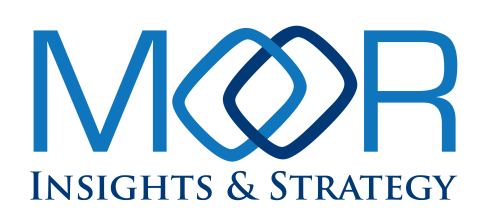
The Moor Insights & Strategy team hopes you had a great weekend!
This week, Patrick, Anshel, and Melody (virtually) will be in Palo Alto at HP Imagine, Anshel will be in San Jose at Meta Connect, and Melody will be at Verint Engage in Orlando.
Last week, Anshel attended the Snap Partner Summit in Santa Monica and Patrick, Jason, Melody, and Robert attended Salesforce Dreamforce in San Francisco (and virtually).
If you missed Will Townsend’s webinar with Zayo, “What’s Next for Your Network’s Foundation?” It is now available on demand!
Our MI&S team published 16 deliverables:
- 6 Forbes Articles
- 1 MI&S Research Paper
- 1 MI&S Research Note
- 5 MI&S Blog Posts
- 3 Podcasts
Over the last week, our analysts have been quoted multiple times in top-tier international publications with our thoughts on Apple, IBM, Intel, and Nokia.
Patrick was on Yahoo! Finance with the Morning Brief team to talk about Intel’s AI chipmaking partnerships, and joined CNBC to discuss recent reports that Qualcomm approached Intel about a takeover.
MI&S Quick Insights
Microsoft, BlackRock, Global Infrastructure Partners, and MGX have partnered to raise $100 billion to build AI infrastructure; the group will invest in datacenters and energy infrastructure to support demand for AI computing power, primarily in the United States. The group’s initial objective is to raise $30 billion, with long-term expectations of expanding it to $100 billion with additional debt financing. The partnership’s main focus will be on datacenters and the power supply needed to run giant AI applications.
A group of Chinese researchers published a paper exploring memory in large language models. The scientists believe that LLMs have a unique type of memory similar to Schrödinger’s cat. The memory can only be observed when a question is asked. The universal approximation theorem (UAT) was used to explain how LLMs can dynamically fit inputs to outputs, making it appear to remember information.
Experiments were run on LLMs by training them on poems, then testing the LLM’s ability to recall the poems based on very little information. It surprised me that the LLMs could remember entire poems based only on titles and authors, even though LLMs don’t store information in a traditional memory structure. The scientists wrapped up the experiment by comparing LLM memory to human cognition. They highlighted similarities and differences and emphasized the potential of the dynamic fitting capability for creativity and innovation.
Microsoft, BlackRock, Global Infrastructure Partners, and MGX have partnered to raise $100 billion to build AI infrastructure; the group will invest in datacenters and energy infrastructure to support demand for AI computing power, primarily in the United States. The group’s initial objective is to raise $30 billion, with long-term expectations of expanding it to $100 billion with additional debt financing. The partnership’s main focus will be on datacenters and the power supply needed to run giant AI applications.
A group of Chinese researchers published a paper exploring memory in large language models. The scientists believe that LLMs have a unique type of memory similar to Schrödinger’s cat. The memory can only be observed when a question is asked. The universal approximation theorem (UAT) was used to explain how LLMs can dynamically fit inputs to outputs, making it appear to remember information.
Experiments were run on LLMs by training them on poems, then testing the LLM’s ability to recall the poems based on very little information. It surprised me that the LLMs could remember entire poems based only on titles and authors, even though LLMs don’t store information in a traditional memory structure. The scientists wrapped up the experiment by comparing LLM memory to human cognition. They highlighted similarities and differences and emphasized the potential of the dynamic fitting capability for creativity and innovation.
Salesforce hosted its Dreamforce event last week, and the big story was Agentforce—its portfolio of tools and capabilities that enable business users to create highly productive AI agents. Agents are pretty exciting AI technology in that they can leverage AI and deterministic programming to let an AI drive a business process and minimize human intervention. Salesforce was able to articulate a set of existing technologies (Mulesoft, Prompt Builder) and new ones (Data Cloud) as well as no-code tools that enable users to easily build agents. While this is very promising, I will caution that, like many developer toolsets embedded in application platforms, Agentforce will still need more work when it comes to enterprise or external deployment. We will need to look closely at how testing and maintenance will function in the new world of agents—and figure out what the right business model is.
A few days prior to Dreamforce, ServiceNow announced its latest AI capabilities in its Xanadu release. In addition to a raft of new features similar to what we are now seeing from Agentforce, Servicenow is releasing a new database to improve performance and scaling, plus a host of new features in its Integration Hub. This aligns well with the thoughts on ServiceNow’s AI aspirations that Melody Brue, Robert Kramer, and I published in June.
IBM is continuing its strategy to cultivate a broad and deep IT automation portfolio. This week it announced its intention to acquire Kubecost, aligning with its Apptio acquisition of 2023. IBM is betting big on FinOps, and Kubecost has the ability to deliver optimized insights to improve the efficiency and costing of Kubernetes infrastructure.
Salesforce has launched Agentforce, an AI-powered suite designed to automate various tasks across an enterprise. Agentforce utilizes autonomous agents to improve efficiency in sales, service, marketing, and commerce. Salesforce emphasizes the platform’s ease of use, accuracy, and ability to deliver immediate results. The AI agents within Agentforce can perform tasks such as drafting e-mails, scheduling meetings, and offering recommendations based on customer data. Salesforce provides pre-built agents such as Service, Sales Development Representative, Sales Coach, and Campaign, while also allowing users to configure their own custom agents. The overarching goals of Agentforce are to empower sales teams, elevate customer experiences, optimize marketing campaigns, and streamline commerce operations through AI-driven automation. Robert Kramer and I talked about Agentforce on the latest episode of the Hot Desk Podcast, and I’ll have more to say in an upcoming analysis article.
The semiconductor space is about as hot as I’ve ever seen it, and it’s only getting hotter. We should be seeing new server CPUs from the two x86 giants hitting the market soon, and of course the AI accelerator market seems to have new, well-funded startups jumping in the game every day. Finally, Arm has driven a new dynamic through its penetration into the cloud (CSP) market that I believe will move downmarket to tier-2 cloud providers and eventually the enterprise.
The CPU is not commoditized. However, the server market is overserved from a scalar compute perspective. Core counts are ridiculously high and the integer performance of chips is beyond what traditional datacenter workloads require. Yes, more is good. And yes, faster is better. But for the enterprise IT organization, we have seen this “cores war” and billboard-style specification comparisons giving way to real value markers such as performance per watt (sustainability, datacenter capacity) and performance per dollar (ROI, TCO).
CSPs have very specific requirements around performance and power which translate into the very specific core counts and performance levels that the CPU makers tout. These are often not CPUs that will be found on price sheets. Furthermore, CSPs require a multi-vendor market. By having more than one supplier, prices are more competitive and different services can be offered.
CPU vendors need to focus marketing spend on real differentiation if they hope to play and win in the enterprise. That differentiation can be virtual machine density or it could be from application acceleration or something else—but the discussion needs to move beyond core counts and memory.
Finally, it is critical to understand that the IT consumer has little faith in published benchmarks from vendors, be it CPU vendors or server vendors. When comparisons are made between your latest technology and a technology that is a generation (or often two) behind—buyers see this. Or when a company publishes a benchmark that shows them with two, three, four orders of magnitude better performance than the competition, their audience realizes it’s synthetic. Let’s move beyond the “benchmarketing” era and into some truth in advertising, so to speak.
Interesting numbers from the last quarter’s financial reporting would indicate that there is softness in storage for some of the major OEMs, despite incredible revenue increases for server sales. Why is this? First, it’s worth picking at those numbers a little more closely. While server revenue numbers were up dramatically across the board, these increases are attributed to AI sales. Non-AI business continues to be flat for most.
What we’ve seen in the market over the last few quarters is storage companies such as Pure and NetApp growing their business as companies like Dell and HPE have seen a flat market. I believe we can thank AI, even if indirectly, for this growth. The focus on AI has led to a focus on data, and this has led organizations to re-examine their storage environments and move toward storage solutions from companies that solely focus on storage and data management. Want more proof? Look at the incredible growth of companies like VAST and Weka—companies that don’t even put an emphasis on the storage element of their solutions.
Lenovo has been the outlier and has seen strong growth. This is due in part to its relatively small customer base and its footprint in the hyperscalers. While I don’t have specific insights, I suspect its enterprise storage business is in line with what we’ve seen from HPE and Dell.
I am certain the OEMs will regain their footing in the storage market. But I don’t believe it will happen until each company examines the way companies like Pure position their products and message to the market.
Veeam Software has acquired AI-powered startup Alcion, which focuses on cyber resilience for Microsoft 365. Alcion’s co-founder, Niraj Tolia, who previously played a key role in Veeam’s Kubernetes data resilience solution Veeam Kasten, has been appointed as Veeam’s new CTO. Tolia will lead the company’s product strategy for Veeam’s new Data Cloud, integrating Alcion’s AI and security features to enhance data resilience. This acquisition is part of Veeam’s broader expansion, which also includes a recent partnership with Lenovo to provide the TruScale Backup Service.
A recent Adobe study highlights the escalating concerns of U.S. consumers regarding misinformation in the lead-up to the 2024 presidential election. The findings reveal that most respondents are worried about the impact of misinformation on the election and have become less trusting of online content.
The study also found a growing demand for transparency in how digital content is created and edited, with a large majority (93%) of consumers emphasizing the importance of understanding content origins and modifications. This demand is particularly strong for election-related content. 95% of respondents said they wanted to see attribution details attached to such information. A significant portion of respondents (48%) have reduced their social media usage due to the prevalence of misinformation, with 89% believing social media platforms should take more decisive action. Most (74%) feel the U.S. government’s efforts to combat online misinformation are inadequate.
Adobe has done a nice job of calling attention to the need for more transparency in digital content—particularly for the company whose tools are designed to manipulate images (yet not in a harmful way). These types of studies are a good way to educate people about the rise in misinformation while promoting the Adobe-led Content Authenticity Initiative.
ServiceNow has introduced AI Agents for automation and intelligent problem-solving to change customer and employee experiences. ServiceNow’s vision for AI Agents is not entirely unique. It is to leverage increasingly powerful AI models to create agents capable of independently identifying and resolving problems. These agents are built to operate within predefined company parameters and with human oversight, ensuring a mix of autonomy and control. It is the human oversight part that I think sets ServiceNow apart from competitors in these early days of AI agent announcements.
Ultimately, ServiceNow envisions a future where humans act as supervisors, guiding teams of AI agents that proactively manage workflows across departments. This represents a significant shift in the human-AI relationship, with AI agents taking on—not taking over—a more active and collaborative role in driving business productivity and transformation. ServiceNow’s initial focus is on customer service management and IT service management.
Introduced last week, Salesforce’s Agentforce is a suite of AI-powered agents designed to enhance business functions. Let’s review a few benefits and challenges when integrating AgentForce with ERP and SCM systems. First, the benefits:
- Automation — AI agents can handle repetitive ERP and SCM tasks such as order processing, inventory management, customer service, procurement processes, etc.
- Data Integration — Tools such as Salesforce’s MuleSoft allow data to flow between systems, although this can also pose challenges.
- Scalability — Agentforce supports increased ERP and SCM workloads without the need for additional human resources.
- Predictive Analytics — Salesforce can enable AI-driven insights drawn from enterprise data that resides in ERP and SCM systems to improve decision-making.
Here are some of the challenges:
- Integration Complexity — Integrating Agentforce with ERP and SCM systems often requires IT expertise; trust in the integration process is critical to avoid operational disruptions.
- Security — Ensuring the protection of sensitive ERP and SCM data when using AI agents deserves significant attention.
- Trust — Users must trust that the data handled by AI agents in ERP and SCM systems is used properly. Errors could impact key functions in the enterprise systems.
- Transparency — It’s important to understand how AI agents make decisions. Transparent AI processes can build trust by helping users understand how decision-making happens in areas such as supply chain optimization and demand forecasting.
More to come on all of this in my upcoming article digging into the details of Agentforce’s impacts on enterprise systems.
Cisco recently announced a second round of layoffs for the year, affecting 5,600 team members, or 7% of its overall workforce. It was a widely anticipated move, given the softness in Cisco’s networking business and an uncertain economy heading into a U.S. presidential election. I expect that the company will use the cost savings to reinvigorate demand for all its infrastructure. This applies especially to cybersecurity, as the integration of Splunk continues to strengthen Cisco’s offering to the market.
Globant is acquiring Blankfactor, a U.S.-based IT consulting firm specializing in payments, banking, and capital markets. This acquisition should strengthen Globant’s financial services offerings, particularly in card issuing, merchant acquiring, and securities finance. Blankfactor’s expertise in consulting-led product engineering, cloud technologies, and AI solutions should complement Globant’s capabilities and help it better serve clients in the rapidly evolving financial services industry.
Amazon has added PayPal as a Buy with Prime checkout option. This builds on last week’s news of PayPal’s expanded partnership with Shopify. This is noteworthy because it expands PayPal’s reach in the e-commerce space, given that it is currently not a payment option on Amazon’s main platform. This strategic move strengthens PayPal’s position in the market and offers more choices for online shoppers. Under the leadership of new CEO Alex Chriss, PayPal seems to be making some strides in creating products and services that compete with newer rivals such as Stripe for payments and Apple for mobile wallets.
HTC has announced a new VR headset, the VIVE Focus Vision. HTC appears to be building this headset for both wireless and wired streaming from a desktop PC—while also enabling it to function as a fully standalone headset. It features mixed reality passthrough for AR-like experiences thanks to two RGB front-facing cameras. It seems that HTC wants this headset to become the standard for PC VR applications; it’s equipped with a 120-degree FoV, 90 Hz LCD panels, and a Qualcomm Snapdragon XR2 chipset. It also has ample RAM (12GB) and storage (128GB, with up to 2TB of expandable storage via MicroSD), as well as swappable batteries. At $999, it will have a hard time competing with Meta’s Quest 3, but given its eye-tracking capabilities and arguably better ergonomics, there is a bit of premium capability. That said, I believe the market fit for this headset is fairly small at the price.
Snap, Inc., parent company of Snapchat, announced a new pair of AR glasses, the fifth generation of its Spectacles family. This is the second generation of Spectacles to have dual see-through waveguide displays. These new Spectacles are powered by a Qualcomm Snapdragon processor running a new Snap OS operating system designed to work with Snap’s developer tools and be compatible with the Snapchat app. While the horizontal field of view is only 46 degrees, the vertical FoV is much taller and seems to lend well to porting Snapchat AR lenses. While the glasses themselves appear quite bulky, I do believe that Snap is taking the right approach to AR by embracing AI and natural interfaces like hand tracking and voice. Other than their appearance and limited FoV, these glasses are still very much targeted towards developers at $99 a month for 12 months.
Matter at the tipping point — At CES 2023, I predicted that Matter, the smart home standard from the Connectivity Standards Alliance, would hit its tipping point in 2025. I figured the CSA and its member companies would iron out the first wave of Matter and Thread bugs during the first year—improving usability, adding more device types, and paving the way for the second wave of commercial products. As it played out, first-year deployments revealed new (but not unexpected) concerns about usability and deployment. This year, Matter and its members addressed the second-order problems, and the Thread Group released Thread 1.4 with essential Matter-related enhancements. I covered Thread 1.4 in these pages in my September 6 weekly update.
Meanwhile, Apple, Amazon, Google, and Samsung have turbocharged Matter’s market acceptance by incorporating Thread and Matter into high-volume consumer products. Google, Apple, and Amazon smart speakers and hubs have Thread and Matter support built-in, so millions of consumers already have the technologies in-house, even though they might not be aware of it. Also, if you have an iPhone 15 Pro or newer with iOS 18, your phone can directly connect with Thread-based Matter devices via its built-in Thread radio—no hub required.
Better usability, increased ecosystem support, and direct device connections combine to reduce initial adoption barriers and improve user experiences. So, as CES 2025 approaches, CE manufacturers are rolling out waves of new products, such as Eve’s recently released wall-mounted, Thread-connected light switch. Using that switch with a Thread-enabled iPhone is the closest thing to a one-click Matter installation I’ve seen. It does look like 2025 will be the tipping point where Matter’s market share accelerates on its way to becoming the leading smart home ecosystem for new products by the end of 2026.
Ikea and Samsung collaborate on Matter support — Last week, Ikea added Matter support to DIRIGERA smart home hubs via a software update. Ikea’s smart home product line, introduced in 2012, includes lighting, remote switches, air purifiers, motorized blinds, and Wi-Fi speakers. Ikea has always used the well-established Zigbee protocol for these products. In 2022, the company launched DIRIGERA for smartphone integration.
Ikea is on the CSA board of directors and a strong Matter supporter, so I wasn’t surprised that the new hub was “Matter-ready” from the start. In this case, Matter-ready meant that a future software update could add “bridging” support, which the Matter specification defines in detail. Bridges translate Zigbee protocol to and from Matter protocol, allowing Matter ecosystems such as Amazon, Apple, Google, and Samsung to control the Ikea non-Matter (Zigbee) devices. Ikea followed through, making good on the promise of a Matter upgrade.
Also, last week, Samsung announced native SmartThings support for DIRIGERA and its Matter bridge. Of course, customers may choose a different smart home system (Apple, Google, Amazon, or other), but I assume Samsung has thoroughly tested SmartThings with Ikea’s bridging. Hear that alarm bell? It’s Ikea and Samsung with a wake-up call for non-Matter smart home suppliers to offer Matter bridges as soon as possible. Proprietary hubs are rapidly becoming obsolete.
T-Mobile launched a new network slice called T-Priority, which is specifically designed to be prioritized above all other users on its network. This service depends on the company’s 5G Standalone network, which it will be upgrading to 5G Advanced by the end of this year. Additionally, this gives it a service to compete with AT&T’s FirstNet, which has been the standard for most first responders. I believe this service will be complementary in many ways and will potentially serve as a backup in some applications as well as a primary line for new 5G applications thanks to its prioritization and larger bandwidth resources. I believe that T-Priority could be very powerful when many emergency services are sharing the same limited FirstNet spectrum and could benefit from added capacity on demand.
The new iPhone 16 might not be selling as well as Apple had anticipated, but the reality is that plenty of consumers are aware that many Apple Intelligence features, including the much-hyped new Siri, won’t be available until next year. Based on comments from T-Mobile’s CEO, it makes sense that there might be a slower start for iPhone sales in Q4, but an eventual ramp-up once the AI features become available broadly. I also believe that this could explain why so many carriers have offered such sweetheart deals on the new iPhone 16 Pro series. This is partially because of the slow rollout of Apple intelligence, but I believe it’s also because the base series iPhone 16 is the closest to the Pro in terms of specs that it has ever been.
8×8 announced the availability of its Video Elevation feature for 8×8 Contact Center. This capability enables contact center agents to initiate one-way video interactions with customers so agents can help quickly resolve issues that may otherwise require a service call or a lengthy discussion. I really like this “show me what you see” functionality, which I have used in different scenarios—most recently when diagnosing a router issue with AT&T. The solution should ensure that the caller and agent are discussing the same thing when trying to resolve an issue. As AI agents start proliferating in the contact center, it might be some time before they can diagnose issues using multimodal recognition.
Zoom has expanded its contact center offerings with three new tools to streamline agent workflows and boost efficiency. Zoom Virtual Agent uses conversational AI to handle routine customer inquiries, freeing human agents for more complex tasks. Agent Assist leverages generative AI to provide real-time support and guidance during customer interactions. The Quality Management tool offers automated transcription and scoring of interactions to facilitate performance evaluation and coaching. These features have become more or less table stakes in contact centers. The significance in this case is that they show Zoom’s strategic focus on leveraging AI to optimize contact center operations and enhance both agent and customer experiences. In addition, Zoom’s AI is quite good. This is suggested by the number of awards and accolades it has received, but also from my own experience. For example, Zoom’s AI noise cancelation is so good that I’ve had people in Zoom meetings apologize for their barking dogs or other background noise that I couldn’t even hear. And more than once when I’ve had to miss or join a meeting late, I’ve been able to accurately and quickly get up to speed thanks to Zoom’s AI meeting summary.
Qedma is one of IBM’s application partners in the initial release of the Qiskit Functions Catalog. Its QESEM (Quantum Error Suppression and Error Mitigation) product is designed to suppress noise created by decoherence and calibration errors in QPUs. That means users can accurately run quantum algorithms on noisy QPUs. According to Qedma, QESEM achieves better results than algorithms that are run without error mitigation.
The QESEM workflow begins by compiling quantum circuits into operations compatible with the QPU. It uses both native and additional operations calibrated by Qedma. Following that, Qedma characterizes errors in the newly compiled circuits. Based on error data, the circuits are reconfigured for optimal QPU execution and then run on the QPU. Lastly, classical postprocessing refines the results and provides estimations with error bars for measured observables.
QESEM provides unbiased output with errors that are primarily statistical and reducible by increasing QPU time. It offers scalability across different qubit numbers without a proportional increase in required QPU time. It also supports several state-of-the-art QPUs, including superconducting qubits and trapped ions. Even though those two cover the biggest part of the quantum market, I expect this will be expanded to other modalities over time.
Ivanti is the latest cybersecurity company to expose a vulnerability that has been exploited in a cyberattack. The endpoint protection provider recently revealed a critical security flaw impacting its cloud service appliance that allows remote access to restricted functionality. Ivanti reports that a limited number of customers have been affected, but regardless of the blast radius it points to broader concerns about the company’s software development process. The timing is not ideal, given the scrutiny over CrowdStrike’s flubbed endpoint protection update. Consequently, Ivanti would be wise to provide additional details and deeper transparency about what it is doing to prevent future vulnerabilities.
I do not believe that most of the talk about Qualcomm acquiring Intel is credible. While I do believe that Qualcomm could potentially absorb or acquire Mobileye, even that would be questionable considering the current FTC climate. Realistically, there’s no way that Intel would sell its PC division, Wi-Fi business, or any of its other businesses—other than potentially its networking business—to Qualcomm. Intel’s PC business is keeping the company afloat right now, and selling it would be corporate suicide. I don’t know which divisions Qualcomm has expressed interest in, but this rumor has been bubbling up for weeks. Frankly, I believe that Qualcomm’s greatest interest in Intel is in supporting its foundry business to enable it to be a more competitive player to challenge TSMC.
The National Football League and Amazon Web Services have renewed their technology partnership, which began in 2017. A key development is the introduction of a new AI-powered Next Gen Stat that changes how tackles in football are analyzed. The Tackle Probability machine-learning model predicts the likelihood of a defender successfully making a tackle during a play, helping to identify the most reliable tacklers and the most elusive ball carriers. The Next Gen Stats platform, supported by AWS, collects over 500 million data points each season, providing detailed statistics and different viewing options for fans. This collaboration also includes tools like the Digital Athlete for injury prevention and the Big Data Bowl, which encourages the use of data insights to improve the experience for fans and players. Check out the details.
SAP provides an ERP-centered approach to carbon management that uses AI to maintain data quality and simplify reporting. Sustainability data helps enterprises track and manage carbon footprints across operations, share sustainability data with partners, and integrate carbon accounting into financial decisions. Though ERP systems can be complex, they are vital for meeting today’s environmental and regulatory demands. By making use of these features, businesses can ensure compliance, improve efficiency, reduce costs, and make informed decisions aligned with sustainability goals.
Look for an upcoming research piece exploring how SAP demonstrates the impact of ERP on sustainability.
AST SpaceMobile’s launch of five commercial low earth orbit satellites on September 12 was a watershed event in supporting direct-to-unmodified-smartphone satellite connectivity. AT&T has been working with the company behind the scenes for nearly four years, and the operator’s financial investment signals confidence in the viability of satellite communications to bridge terrestrial mobile network coverage gaps. Moor Insights & Strategy will be publishing a podcast soon highlighting a conversation with Chris Sambar, president of AT&T Network, and Abel Avellan, CEO of AST SpaceMobile, discussing the launch and its broader implications.
Forbes Articles Published
- Intel Makes a Slew of Announcements Supporting Its Turnaround Strategy – Patrick Moorhead
- Alienware 32-Inch 4K QD-OLED Monitor Review — A Great Gaming Monitor – Anshel Sag
- Qiskit Functions: IBM’s Quantum Game-Changer – Paul Smith-Goodson
- XMEMS Cooling Turns Micro Speaker Tech Into Micro Cooling Tech – Anshel Sag
- Zoho Analytics Advances Self-Service BI with AI-Powered Tools – Melody Brue
Research Papers Published
- Enabling Enterprise Network Transformation at Scale – Will Townsend, Patrick Moorhead
Blog Posts Published
- Adobe Launches AI-Driven B2B Marketing Solution – Melody Brue, Patrick Moorhead
- Embracing AI to Augment, Not Replace, the Status Quo – Jason Andersen
- AWS Summit New York 2024: Democratizing Data and AI – Robert Kramer, Patrick Moorhead
- Broadcom’s Hock Tan Declares ‘The Future is Private’ at VMware Explore – Patrick Moorhead
- Say Ahh to AI: How the Tongue Can Reveal Hidden Health Issues – Paul Smith-Goodson, Patrick Moorhead
Podcasts Published
MI&S Hot Desk Podcast (Melody Brue, Robert Kramer)
MI&S Game Time Tech (Melody Brue, Robert Kramer, and IBM’s Noah Syken )
Six Five (Patrick Moorhead)
The Futurum Group Enterprising Insights Podcast (Guest: Robert Kramer)
Don’t miss future MI&S Podcast episodes! Subscribe to our YouTube Channel here.
Citations
Apple / Airpods 2 / Anshel Sag / Soft Impact
Apple’s AirPods Pro 2 could forever change how people access hearing aids
IBM / Layoff’s / Jason Andersen / Computer World
IBM has reportedly laid off thousands
Intel / AWS Partnership & Government contracts / Patrick Moorhead / New York TImes
Intel, Aiming to Reverse Slump, Unveils New Contracts and Cost Cuts
Intel / AWS Partnership & Government contracts / Patrick Moorhead / TechTarget
Intel gets boost from AWS, government contracts
Intel / AWS Partnership & Government contracts / Patrick Moorhead / AOL – Business Insider
Intel, once a Silicon Valley star, has been floundering. Now it’s mounting a turnaround.
Intel / Re-organizaiton of Foundry / Patrick Moorhead / MarketWatch
Why Intel’s latest move for its foundry business is so significant
Intel / Re-organizaiton of Foundry / Patrick Moorhead / RCR Wireless News
Intel announces re-org focused on foundry business
Intel / Re-organizaiton of Foundry / Patrick Moorhead / Silicon Angle
On theCUBE Pod: Analysts debate Intel Foundry spinout, AI tsunami and Oracle-AWS cloud moves
Nokia / APIs / Will Townsend / Fierce Network
Nokia: Ericsson’s new JV validates our approach to APIs
TV Interviews
Intel / AWS Partnership / Patrick Moorhead / Yahoo! Finance
Intel’s partnerships are boosting investor confidence: Analyst
Intel / Shares / Patrick Moorhead / CNBC
Intel shares climb after reports Qualcomm approached Intel about a takeover
New Gear or Software We Are Using and Testing
- Cisco Desk Pro (Melody Brue)
- OnePlus Buds Pro 3 (Anshel Sag)
- Insta360 Link2 4K AI Webcam (Anshel Sag)
- Pixel Watch 3 (Anshel Sag)
- Pixel 9 Pro Fold (Anshel Sag)
Events MI&S Plans on Attending In-Person or Virtually (New)
Unless otherwise noted, our analysts will be attending the following events in person.
- Intel Innovation, September 23-26 — EVENT CANCELED
- HP Imagine, September 24, Palo Alto (Patrick Moorhead, Anshel Sag)
- Meta Connect, September 25, San Jose (Anshel Sag)
- Verint Engage, September 23-25, Orlando (Melody Brue)
- Infor Annual Summit, September 30-October 2, Las Vegas (Robert Kramer)
- Intel Innovation, September 23-26 — EVENT CANCELED
- HP Imagine, September 24, Palo Alto (Patrick Moorhead, Anshel Sag)
- Meta Connect, September 25, San Jose (Anshel Sag)
- Verint Engage, September 23-25, Orlando (Melody Brue)
- Infor Annual Summit, September 30-October 2, Las Vegas (Robert Kramer)
- Fem.AI Summit, Menlo Park, October 1 (Melody Brue)
- Microsoft Industry Analyst Event, Burlington, Mass, October 2 (Melody Brue)
- LogicMonitor, Austin, October 2-4 (Robert Kramer)
- Teradata, October 7-10, Los Angeles (Robert Kramer)
- Zoomtopia, San Jose, October 8-9 (Melody Brue)
- Embedded World NA, Austin, October 8-10 (Bill Curtis)
- MWC Americas and T-Mobile for Business Unconventional Awards event judge, October 8-10, Las Vegas (Will Townsend)
- AMD Event, San Francisco, October 8-10 (Matt Kimball)
- AWS GenAI Summit, October 9-10, Seattle (Jason Andersen, Robert Kramer)
- AdobeMAX, October 14-16, Miami (Melody Brue)
- Lenovo Global Analyst Summit & Tech World, October 14-17, Bellevue, WA (Matt Kimball, Paul Smith-Goodson, Anshel Sag)
- IBM Analyst Summit, October 16-18, New York City (Matt Kimball, Robert Kramer)
- Snapdragon Summit, Maui, October 20-24 (Will Townsend)
- WebexOne, October 21-24, Miami (Melody Brue)
- RISC-V Summit, October 22-23 — virtual (Matt Kimball)
- Cisco Partner Summit, Los Angeles, October 28–30, 2024 (Robert Kramer)
- SAP SuccessConnect, October 28-30 – virtual (Melody Brue)
- Red Hat Analyst Day, October 29 (Jason Andersen — virtual)
- GitHub Universe, October 29-30, San Francisco (Jason Andersen)
- 5G Techritory, October 30-31, Riga (Will Townsend)
- Dell Tech Analyst Summit, November 6-8, Austin (Matt Kimball, Anshel Sag, Paul Smith-Goodson)
- Apptio TBM Conference, November 4-5, San Diego (Jason Andersen)
- IBM, November 6-8, New York City (Paul Smith-Goodson)
- Fyuz, November 11-13, Dublin (Will Townsend)
- Veeam Analyst Summit, November 11-13, Scottsdale, AZ (Robert Kramer)
- Box Analyst Summit, November 12-13, San Francisco (Melody Brue)
- Microsoft Ignite, November 18-22, Chicago (Robert Kramer – virtual, Will Townsend – virtual)
- Super Computing, November 18-22, Atlanta (Matt Kimball)
- NTT R&D Forum, November 19-23, Tokyo (Will Townsend)
- AWS re:Invent, December 2-6, Las Vegas (Robert Kramer, Will Townsend, Jason Andersen, Paul Smith-Goodson)
- T-Mobile Analyst Summit, December 9-10 (Anshel Sag)
- Marvel Industry Analyst Day, December 10, Santa Clara (Matt Kimball)
- ServiceNow Global Industry Analyst Digital Summit, December 10 (Jason Andersen, Melody Brue, Robert Kramer – virtual)
Subscribe
Want to talk to the team? Get in touch here!






























































































